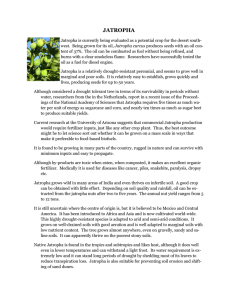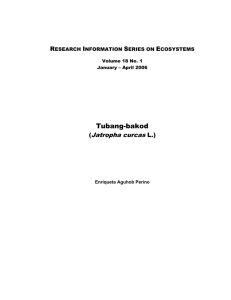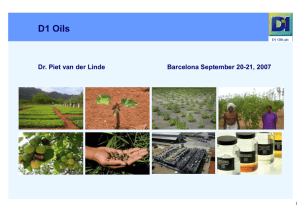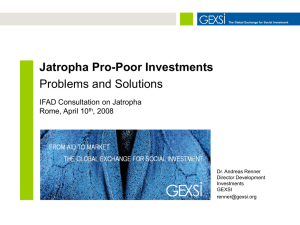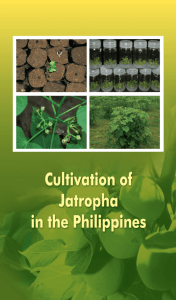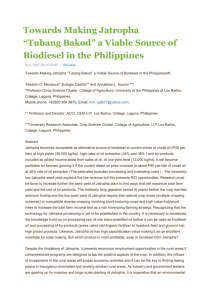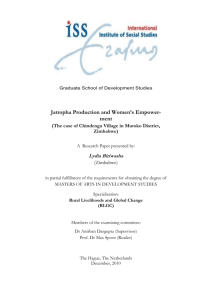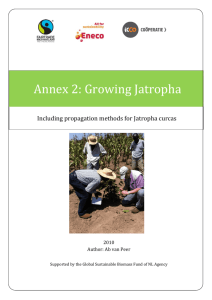JATROPHA Propagation - Department of Agriculture
advertisement
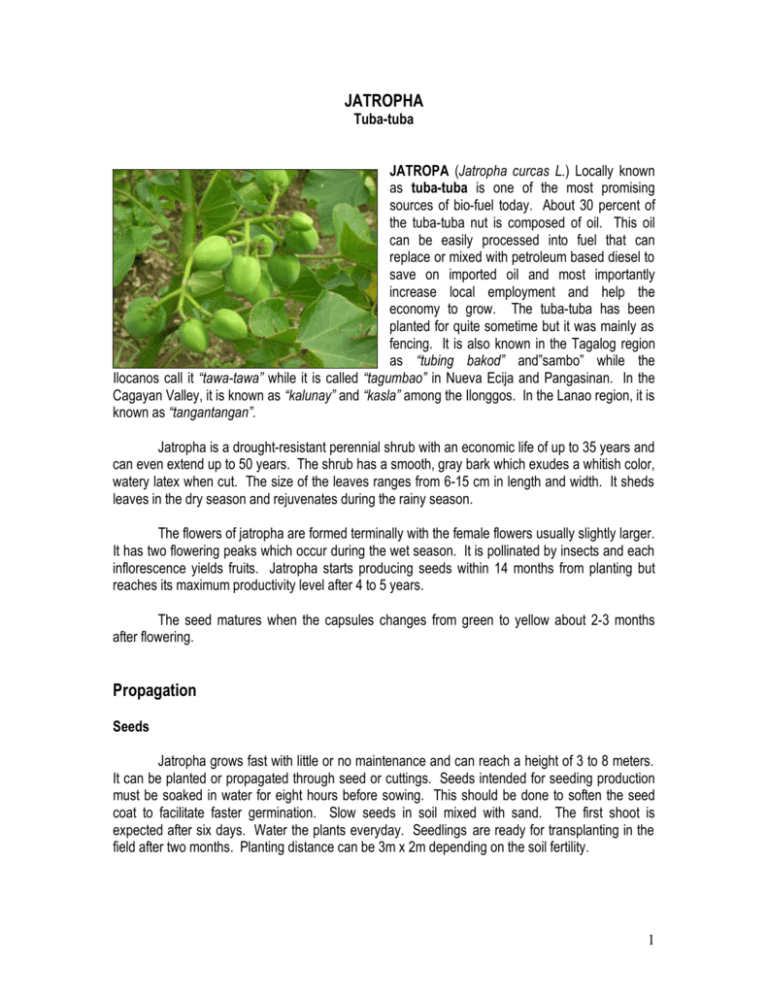
JATROPHA Tuba-tuba JATROPA (Jatropha curcas L.) Locally known as tuba-tuba is one of the most promising sources of bio-fuel today. About 30 percent of the tuba-tuba nut is composed of oil. This oil can be easily processed into fuel that can replace or mixed with petroleum based diesel to save on imported oil and most importantly increase local employment and help the economy to grow. The tuba-tuba has been planted for quite sometime but it was mainly as fencing. It is also known in the Tagalog region as “tubing bakod” and”sambo” while the Ilocanos call it “tawa-tawa” while it is called “tagumbao” in Nueva Ecija and Pangasinan. In the Cagayan Valley, it is known as “kalunay” and “kasla” among the Ilonggos. In the Lanao region, it is known as “tangantangan”. Jatropha is a drought-resistant perennial shrub with an economic life of up to 35 years and can even extend up to 50 years. The shrub has a smooth, gray bark which exudes a whitish color, watery latex when cut. The size of the leaves ranges from 6-15 cm in length and width. It sheds leaves in the dry season and rejuvenates during the rainy season. The flowers of jatropha are formed terminally with the female flowers usually slightly larger. It has two flowering peaks which occur during the wet season. It is pollinated by insects and each inflorescence yields fruits. Jatropha starts producing seeds within 14 months from planting but reaches its maximum productivity level after 4 to 5 years. The seed matures when the capsules changes from green to yellow about 2-3 months after flowering. Propagation Seeds Jatropha grows fast with little or no maintenance and can reach a height of 3 to 8 meters. It can be planted or propagated through seed or cuttings. Seeds intended for seeding production must be soaked in water for eight hours before sowing. This should be done to soften the seed coat to facilitate faster germination. Slow seeds in soil mixed with sand. The first shoot is expected after six days. Water the plants everyday. Seedlings are ready for transplanting in the field after two months. Planting distance can be 3m x 2m depending on the soil fertility. 1 Stem cutting Another method of propagating jatropha is through stem cutting. It is important to obtain cuttings from eight month-old mature plant. Use a sharp bolo to cut the stem about 30 cm long from the base of the stem. Matured cuttings was found to be the best source of planting materials that can easily produce seeds at least 6 months earlier than from seeds. Tissue culture Jatropha can also be propagated through tissue culture. This method is a laboratory – based which uses artifificial and sterilized propagation media. Tissues from various plants can be used in this procedure which allows asexual propagation of plants with desired characteristics. In order to obtain a higher rate of survival of planting materials, it is important to establish a nursery that is accessible to the plantation that has a source of water. Cultivation Jatropha grows on all types of soil (ordinary soil, sandy, gravely or rocky soil) and adapts easily to different climates. It can survive a long period of drought by shedding most of it leaves. It can stand up to two years without rainfall. The tree also has a short gestation period, it will bear a several fruits starting at about 8 months old and be fully fruit bearing between one to two years. It can be adapted to marginal soils with low nutrient content but the use of organic fertilizer would result to higher yield. It grows best when planted at the onset of the rainy season. The distance of planting for commercial production is 2m x 2m apart but for hedges, the recommended distance of planting is 1m x 1m. The trees can also be planted on coconut plantations – intercropping the tuba-tuba under the coconut trees provided that it receives sufficient sunlight. The plants must be watered up to two weeks after transplanting to ensure its continued growth. In order to obtain higher yield and better quality seeds, fertilizer application is recommended. To prevent wilting, plants must be watered after applying fertilizer. For rainfed areas, fertilizer can be applied during rainy season. Apply fertilizer at a depth of 5-10cm and a distance of 15-20cm away from the plant. Organic fertilizer is highly recommended for jatropha production. Harvesting and Processing Seeds can usually be harvested one year after planting. It is best to harvest the fruits when these have turned yellow to dark brown. Approximately two to three months after flowering, seeds should be collected when the capsules have split open. Seeds should not be dried in direct sunlight because it will affect its germination. One kilogram of jatropha seeds consists of 600 to 1,600 pieces of seeds. The potential yield of jatropha per hectare is 6 tons to as high as 1o tons depending on the site, climate and management of the plants. Seeds are de-hulled by using wooden plank and then winnowed to separate the hulls from the seeds. Before storing, the seeds 2 must be air dried to 5% - 7% moisture content and stored in air-tight containers. Seeds can be stored up to one year at room temperature. Seeds for replanting can be gathered when fruits are already yellow to dark brown. Dry, black seeds can be used for oil extraction. Technology Oil Production The extraction process involves the use of machines to extract the vegetable oil from the seed. This produces Jatropha crude oil, with hull and press cake as by products. Laboratory results show that around 2.9 kg of seeds produces one liter of crude oil. Refining of oil into biodiesel On the other hand, the transesterification of crude oil is a process which uses chemicals like methanol and catalysts such as caustic soda. This produces Jatropha Methyl Ester (JME) as its main product and glycerine as its co-product. 10 liters of crude oil can produce 8.5 liters of JME. The results of testing made on Philippine Forest’s JME show the great potential of Jatropha oil as a source of biodiesel. Laboratory tets showed that it passes the American (ASTM D6751) and European (EN 14214) standards for biodiesel. Moreover, analysis of Jatropha crude oil shows that it is comparable to bunker fuel. Uses Jatropha is a potential source of biodiesel for local production to replace a portion of the country’s dependence on imported oil. The extracted oil from jatropha can be used in diesel engines (in lover blends with diesel fuel). Blending of fuel can be done up to 20 percent (B20) without engine modification. Using jatropha as biodiesel reduces greenhouse gas emissions. Jatropha can be grown on marginal and degraded land, thus, leaving prime agricultural lands for food crops, and at the same time restoring the fertility of these marginal lands. Aside from using the seed oil as biodiesel, the extracted oil can also be used in making soap. The leaves can be used for fumigating houses to expel bugs. The root extract can be used as yellow dye while the bark extract as blue dye. The seeds when pounded can be used for tanning while the roots, flowers and latex of the tuba-tuba plant are said to have medicinal properties. With the ever increasing interest in biodiesel fuels, we may be one day get used to the idea that fuel for our vehicles was harvested from local plantations instead of using imported oil. 3 Economics Initial investment for commercial plantation (2m x 2m) for one hectare ranges from Php31,009 to Php52,770. the return of investment ranges from 0.90 – 1.8 while payback period is between 2nd to 3rd year. Potential yield ranges from 6 tons to as high as 10 tons per hectare depending on the site, climate and tending operations. References 1. Primer on department of Energy’s Alternative Fuels Program Web? FAQs 2. how to Grow Jatropha for Biodiesel-Philippine Forest Corporation Prepared by the: Agriculture and Fisheries Information Service Department of Agriculture Elliptical Road, Diliman, Quezon City 1100 Tel. No.: 9288741 local 2156 DA TIN No.: 000-845-895-000 Webpage: www.da.gov.ph In coordination with Philippine Forest Corporation Old Namria Building, Lawton Avenue Fort Bonifacio, Taguig City Tel.: 8893573 March 2007 4



